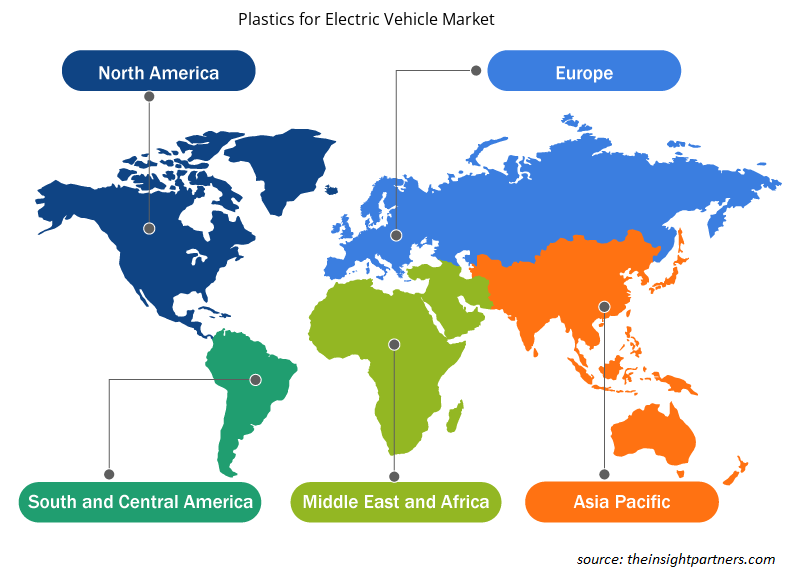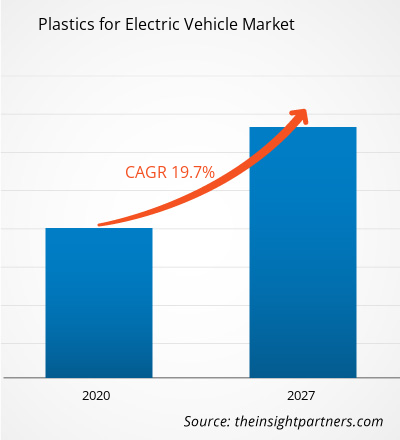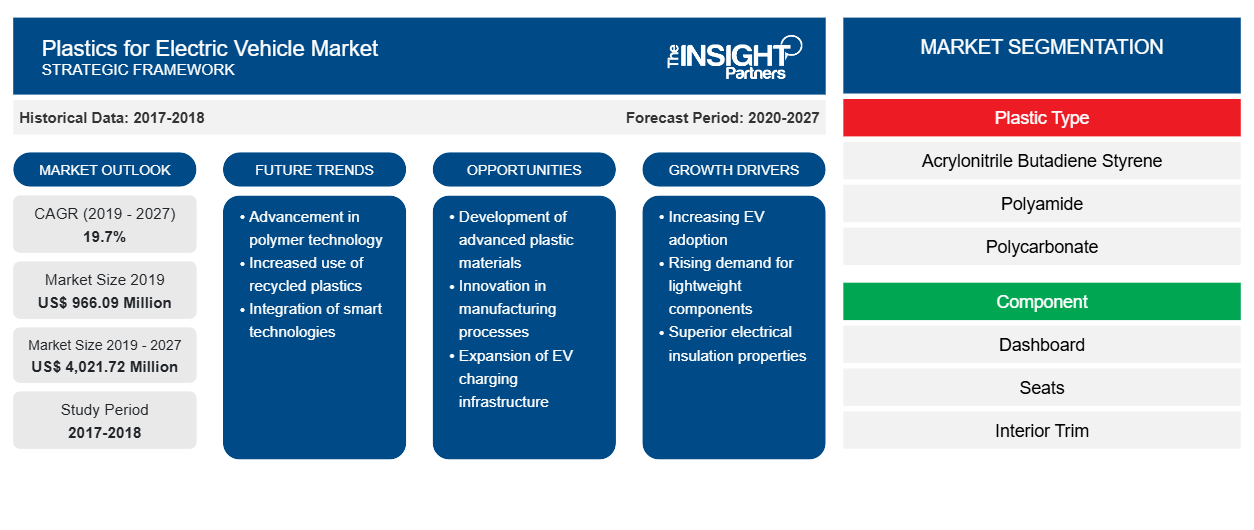El mercado de plástico para vehículos eléctricos se valoró en US$ 966,09 millones en 2019 y se proyecta que alcance los US$ 4.021,72 millones en 2027; se espera que crezca a una CAGR del 19,7% entre 2020 y 2027.
Los plásticos pueden ser conductores eléctricos y también aislantes. Los polímeros termoplásticos se pueden producir en diversas formas y diseños según los requisitos de los vehículos eléctricos debido a la alta versatilidad y la fácil moldeabilidad de los plásticos. El uso de plásticos para vehículos eléctricos reduce el peso de estos vehículos, lo que proporciona una mayor autonomía entre recargas. Los plásticos ofrecen una excelente resistencia al calor que permite la construcción de compartimentos de batería y sistemas de refrigeración y no obstaculizan la durabilidad y la seguridad que brindan los vehículos eléctricos. Se espera que el mercado mundial de plásticos para vehículos eléctricos en América del Norte crezca a la CAGR más alta del 20,0 % durante 2020-2027.
La pandemia de COVID-19 se informó por primera vez en Wuhan (China) en diciembre de 2019. A junio de 2020, Estados Unidos, Rusia, India, España, Brasil, Italia, Francia y Alemania se encuentran entre los países más afectados en términos de casos positivos de COVID-19 y muertes reportadas. El brote está afectando negativamente a las economías e industrias debido a los bloqueos , las prohibiciones de viaje y los cierres de negocios. Los productos químicos y los materiales son una de las principales industrias del mundo que sufre graves interrupciones en forma de interrupciones de la cadena de suministro, cancelaciones de eventos tecnológicos y cierres de oficinas. China es el centro de fabricación mundial y el mayor proveedor de materias primas para varias industrias en todo el mundo, y también es uno de los países más afectados por la pandemia de COVID-19. El cierre de varias plantas y fábricas en China está restringiendo las cadenas de suministro globales y la fabricación y venta de varios productos químicos y materiales. En consecuencia, el impacto general de la pandemia está restringiendo el crecimiento del mercado de plástico para vehículos eléctricos.
Personalice este informe según sus necesidades
Obtendrá personalización en cualquier informe, sin cargo, incluidas partes de este informe o análisis a nivel de país, paquete de datos de Excel, así como también grandes ofertas y descuentos para empresas emergentes y universidades.
- Obtenga las principales tendencias clave del mercado de este informe.Esta muestra GRATUITA incluirá análisis de datos, desde tendencias del mercado hasta estimaciones y pronósticos.
Perspectivas del mercado
La creciente demanda de vehículos eléctricos impulsa el crecimiento del mercado
La fabricación de automóviles está cambiando hacia la generación de menos emisiones de gases de efecto invernadero y hacia una mayor eficiencia en el uso del combustible, con un énfasis creciente en la sostenibilidad ambiental. La relación costo-beneficio, la sostenibilidad ambiental, la conveniencia, la adopción de tecnología avanzada y diversas políticas gubernamentales, como tarifas preferenciales, incentivos para la compra de equipos y descuentos significativos, se encuentran entre los factores que impulsan la demanda de vehículos eléctricos en todo el mundo. Según la AIE , en 2019 se registró un aumento interanual del 40%, con las ventas de 2,1 millones de automóviles eléctricos a nivel mundial, superando significativamente las de 2018.
Información sobre los tipos de plástico
Según el tipo de plástico, el mercado de plásticos para vehículos eléctricos se segmenta en acrilonitrilo butadieno estireno (ABS), poliamida (PA), policarbonato (PC), polivinil butiral, poliuretano (PU), polipropileno (PP) y otros. El segmento de polipropileno (PP) representó la mayor participación del mercado en 2019. El polipropileno (PP) se refiere a un "polímero de adición" termoplástico que se produce mediante la combinación de monómeros de propileno. Es rígido y cristalino; por lo tanto, se usa ampliamente para fabricar objetos como bandejas de embalaje, dispositivos médicos y otros. Como parte de la importante familia de resinas de poliolefina, se moldea y extruye en cualquier tipo de plástico que requiera flexibilidad, tenacidad, ligereza y resistencia al calor.
Información sobre componentes
Según los componentes, el mercado de plástico para vehículos eléctricos se segmenta en tableros, asientos, molduras interiores, tapicería del automóvil, parachoques y otros. El segmento de molduras interiores representó la mayor participación del mercado en 2019. Las molduras interiores de un vehículo eléctrico se refieren a los componentes o paneles de plástico que están presentes dentro de la cabina. Las molduras funcionales y estéticas con características agradables son esenciales para brindar una experiencia interior perfecta.
Información sobre el tipo de vehículo
Según el tipo de vehículo, el mercado de plásticos para vehículos eléctricos se divide en BEV y PHEV/HEV. El segmento BEV representó la mayor participación del mercado en 2019. Los vehículos eléctricos de batería o BEV almacenan electricidad a bordo con paquetes de baterías de alta capacidad. La energía de la batería se utiliza para hacer funcionar el motor eléctrico y otros dispositivos electrónicos a bordo. Los plásticos se utilizan en la fabricación de conectores y carcasas para los componentes eléctricos que se requieren en los vehículos eléctricos.
Información sobre aplicaciones
Según la aplicación, el mercado de plástico para vehículos eléctricos se segmenta además en sistema de tren motriz/bajo el capó, exterior, interior e iluminación y cableado eléctrico. El segmento interior representó la mayor participación del mercado en 2019. Los plásticos de alto rendimiento se utilizan en vehículos eléctricos para brindar seguridad y protección. El polipropileno se utiliza con frecuencia en las piezas de los automóviles, como los bidones de gasolina y las fibras de alfombra del suelo interior. El PVC se utiliza en los tanques y los tableros de instrumentos de los automóviles debido a su acabado elegante. Los volantes y los tableros también se producen con acrilonitrilo butadieno estireno o plásticos ABS. La aplicación a gran escala de plásticos en los volantes, el suelo interior y las consolas favorece el crecimiento del mercado de plásticos para vehículos eléctricos para el segmento de molduras interiores.
Perspectivas regionales sobre el mercado de plásticos para vehículos eléctricos
Los analistas de Insight Partners explicaron en detalle las tendencias y los factores regionales que influyen en el mercado de plásticos para vehículos eléctricos durante el período de pronóstico. Esta sección también analiza los segmentos y la geografía del mercado de plásticos para vehículos eléctricos en América del Norte, Europa, Asia Pacífico, Oriente Medio y África, y América del Sur y Central.

- Obtenga datos regionales específicos para el mercado de plásticos para vehículos eléctricos
Alcance del informe sobre el mercado de plásticos para vehículos eléctricos
| Atributo del informe | Detalles |
|---|---|
| Tamaño del mercado en 2019 | US$ 966,09 millones |
| Tamaño del mercado en 2027 | US$ 4.021,72 millones |
| CAGR global (2019-2027) | 19,7% |
| Datos históricos | 2017-2018 |
| Período de pronóstico | 2020-2027 |
| Segmentos cubiertos | Por tipo de plástico
|
| Regiones y países cubiertos | América del norte
|
| Líderes del mercado y perfiles de empresas clave |
|
Densidad de actores del mercado de plásticos para vehículos eléctricos: comprensión de su impacto en la dinámica empresarial
El mercado de plásticos para vehículos eléctricos está creciendo rápidamente, impulsado por la creciente demanda de los usuarios finales debido a factores como la evolución de las preferencias de los consumidores, los avances tecnológicos y una mayor conciencia de los beneficios del producto. A medida que aumenta la demanda, las empresas amplían sus ofertas, innovan para satisfacer las necesidades de los consumidores y aprovechan las tendencias emergentes, lo que impulsa aún más el crecimiento del mercado.
La densidad de actores del mercado se refiere a la distribución de las empresas o firmas que operan dentro de un mercado o industria en particular. Indica cuántos competidores (actores del mercado) están presentes en un espacio de mercado determinado en relación con su tamaño o valor total de mercado.
Las principales empresas que operan en el mercado de plásticos para vehículos eléctricos son:
- BASF SE
- Solvay SA
- DuPont de Nemours, Inc.
- La compañía química Dow
- LG Chem Ltd
Descargo de responsabilidad : Las empresas enumeradas anteriormente no están clasificadas en ningún orden particular.

- Obtenga una descripción general de los principales actores clave del mercado de plásticos para vehículos eléctricos
Informe Destacado
- Tendencias progresivas de la industria en el mercado mundial de plásticos para vehículos eléctricos que ayudan a los actores a desarrollar estrategias efectivas a largo plazo
- Estrategias de crecimiento empresarial adoptadas por los mercados desarrollados y en desarrollo
- Análisis cuantitativo del mercado de plásticos para vehículos eléctricos de 2017 a 2027
- Estimación de la demanda de plástico para vehículos eléctricos en diversas industrias a nivel mundial
- Análisis PEST para ilustrar la eficacia de los compradores y proveedores que operan en el mercado
- Desarrollos recientes para comprender el escenario competitivo del mercado y la demanda de plástico para vehículos eléctricos
- Tendencias y perspectivas del mercado y factores que impulsan y restringen el crecimiento del mercado
- Comprensión de las estrategias que sustentan el crecimiento del mercado mundial de plástico para vehículos eléctricos, lo que ayuda a las partes interesadas en la toma de decisiones.
- Tamaño del mercado de plástico para vehículos eléctricos en varios nodos del mercado
- Descripción detallada y segmentación del mercado y dinámica de la industria.
- Tamaño del mercado mundial de plástico para vehículos eléctricos en varias regiones con oportunidades de crecimiento prometedoras en estas regiones
Mercado de plásticos para vehículos eléctricos, por tipo de plástico
- Acrilonitrilo butadieno estireno
- Poliamida
- Policarbonato
- Butiral de polivinilo
- Poliuretano
- Polipropileno
- Otros
Mercado de plásticos para vehículos eléctricos, por componente
- Panel
- Asientos
- Acabado interior
- Tapicería de automóviles
- Parachoques
- Otros
Mercado de plásticos para vehículos eléctricos, por tipo de vehículo
- VEB
- Vehículos híbridos enchufables (PHEV) y vehículos híbridos eléctricos (HEV)
Mercado de plásticos para vehículos eléctricos, por aplicación
- Sistema de tren motriz/debajo del capó
- Exterior
- Interior
- Iluminación y cableado eléctrico
Perfiles de empresas
- BASF SE
- Solvay SA
- DuPont de Nemours, Inc.
- La compañía química Dow
- Compañía química LG Ltd.
- Lanxess AG
- Sabic
- Covestro AG
- Corporación Asahi Kasei
- Lyondellbasell Industries Holdings BV
- Análisis histórico (2 años), año base, pronóstico (7 años) con CAGR
- Análisis PEST y FODA
- Tamaño del mercado, valor/volumen: global, regional y nacional
- Industria y panorama competitivo
- Conjunto de datos de Excel
Informes recientes
Informes relacionados
Testimonios
Razón para comprar
- Toma de decisiones informada
- Comprensión de la dinámica del mercado
- Análisis competitivo
- Información sobre clientes
- Pronósticos del mercado
- Mitigación de riesgos
- Planificación estratégica
- Justificación de la inversión
- Identificación de mercados emergentes
- Mejora de las estrategias de marketing
- Impulso de la eficiencia operativa
- Alineación con las tendencias regulatorias























 Obtenga una muestra gratuita para - Plásticos para el mercado de vehículos eléctricos
Obtenga una muestra gratuita para - Plásticos para el mercado de vehículos eléctricos